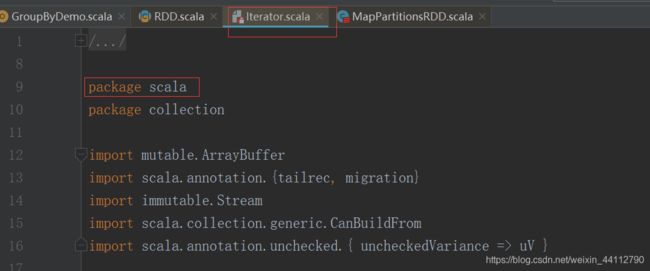Spark源码学习之RDD的常见算子(2)
前言
上一篇博客讨论了RDD的一些算子间的关系,留下了两个疑问,这篇博客先来解决第一个问题:iter到底是个什么?
MapPartitionsRDD
仔细来看,其实是创建了一个MapPartitionsRDD,iter是它的一个参数
def flatMap[U: ClassTag](f: T => TraversableOnce[U]): RDD[U] = withScope {
val cleanF = sc.clean(f)
new MapPartitionsRDD[U, T](this, (context, pid, iter) => iter.flatMap(cleanF))
}
sc.clean(f)在清理一些闭包问题,避免函数的外部变量序列化失败或者避免不必要的网络传输。
MapPartitionsRDD源码不多,就在下面。
private[spark] class MapPartitionsRDD[U: ClassTag, T: ClassTag](
var prev: RDD[T],
f: (TaskContext, Int, Iterator[T]) => Iterator[U], // (TaskContext, partition index, iterator)
preservesPartitioning: Boolean = false)
extends RDD[U](prev) {
override val partitioner = if (preservesPartitioning) firstParent[T].partitioner else None
override def getPartitions: Array[Partition] = firstParent[T].partitions
override def compute(split: Partition, context: TaskContext): Iterator[U] =
f(context, split.index, firstParent[T].iterator(split, context))
override def clearDependencies() {
super.clearDependencies()
prev = null
}
}
不难看到MapPartitionsRDD的一个属性f,这个函数将TaskContext,、Int、Iterator[T]转为Iterator[U],但是却没有具体的实现过程。这条线索好些看不到更多关于iter的细节了,那么再进入iter的flatMap方法看看,可以得到如下的代码。
def flatMap[B](f: A => GenTraversableOnce[B]): Iterator[B] = new AbstractIterator[B] {
private var cur: Iterator[B] = empty
private def nextCur() { cur = f(self.next()).toIterator }
def hasNext: Boolean = {
// Equivalent to cur.hasNext || self.hasNext && { nextCur(); hasNext }
// but slightly shorter bytecode (better JVM inlining!)
while (!cur.hasNext) {
if (!self.hasNext) return false
nextCur()
}
true
}
再看看现在所在的位置,居然来到了Scala的源码包

再想想MapPartitionsRDD指定的类型,其实也没什么问题。
同样返回MapPartitionsRDD的算子还有map、filter这些。
def map[U: ClassTag](f: T => U): RDD[U] = withScope {
val cleanF = sc.clean(f)
new MapPartitionsRDD[U, T](this, (context, pid, iter) => iter.map(cleanF))
}
def filter(f: T => Boolean): RDD[T] = withScope {
val cleanF = sc.clean(f)
new MapPartitionsRDD[T, T](
this,
(context, pid, iter) => iter.filter(cleanF),
preservesPartitioning = true)
}
可以看到手法都是一样的
既然有MapPartitionsRDD继承了RDD,应该还有其他RDD的子类吧?下面就来看看这个
PartitionwiseSampledRDD
抽样这个也比较好理解,返回的是一个PartitionwiseSampledRDD
def sample(
withReplacement: Boolean,
fraction: Double,
seed: Long = Utils.random.nextLong): RDD[T] = {
require(fraction >= 0,
s"Fraction must be nonnegative, but got ${fraction}")
withScope {
require(fraction >= 0.0, "Negative fraction value: " + fraction)
if (withReplacement) {
new PartitionwiseSampledRDD[T, T](this, new PoissonSampler[T](fraction), true, seed)
} else {
new PartitionwiseSampledRDD[T, T](this, new BernoulliSampler[T](fraction), true, seed)
}
}
}
CoalescedRDD
这是对RDD重新进行了分区
def coalesce(numPartitions: Int, shuffle: Boolean = false,
partitionCoalescer: Option[PartitionCoalescer] = Option.empty)
(implicit ord: Ordering[T] = null)
: RDD[T] = withScope {
require(numPartitions > 0, s"Number of partitions ($numPartitions) must be positive.")
if (shuffle) {
/** Distributes elements evenly across output partitions, starting from a random partition. */
val distributePartition = (index: Int, items: Iterator[T]) => {
var position = (new Random(index)).nextInt(numPartitions)
items.map { t =>
// Note that the hash code of the key will just be the key itself. The HashPartitioner
// will mod it with the number of total partitions.
position = position + 1
(position, t)
}
} : Iterator[(Int, T)]
// include a shuffle step so that our upstream tasks are still distributed
new CoalescedRDD(
new ShuffledRDD[Int, T, T](mapPartitionsWithIndex(distributePartition),
new HashPartitioner(numPartitions)),
numPartitions,
partitionCoalescer).values
} else {
new CoalescedRDD(this, numPartitions, partitionCoalescer)
}
}
还有一个repartition算子,区别在于shuffle为true
def repartition(numPartitions: Int)(implicit ord: Ordering[T] = null): RDD[T] = withScope {
coalesce(numPartitions, shuffle = true)
}
关于二者使用上的区别,推荐一篇博客。
总结
刚刚接触到了一些RDD的子类,限于篇幅,关于RDD的子类不再展开叙述。这里只给出一张图

在IDEA中Ctrl+H就可以查看到